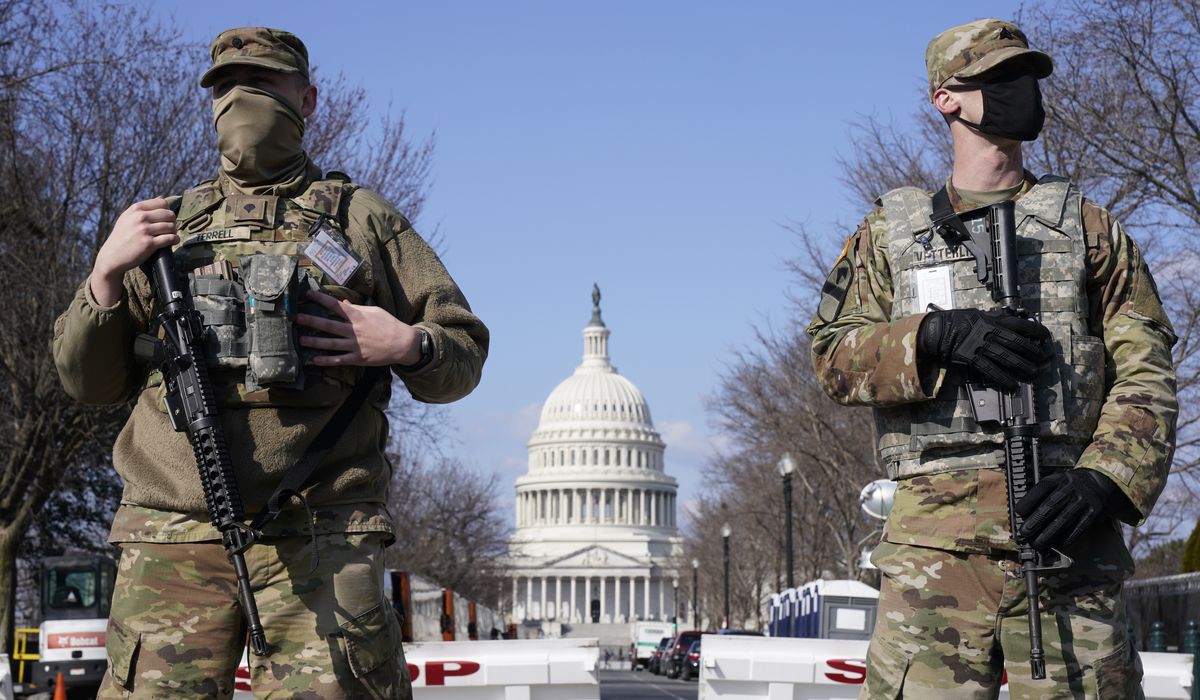

The U.S. Capitol Police will begin fielding military surveillance equipment as part of sweeping security upgrades as the police force pivots towards becoming “an intelligence-based protective agency” following the Jan. 6 attack.
Defense Secretary Loyd Austin recently approved the Capitol Police’s request for eight Persistent Surveillance Systems Ground – Medium (PSSG-M) units. The system provides high-definition surveillance video and is enabled with night vision. The system does not include facial recognition capabilities, according to the Pentagon.
“This technology will be integrated with existing USCP camera infrastructure, providing greater high definition surveillance capacity to meet steady-state mission requirements and help identify emerging threats,” the Pentagon said.
The technology, originally used by the U.S. troops during the wars in Iraq and Afghanistan, allows the user to monitor large areas 24/7 through extremely high-resolution cameras.
The deployment of battlefield technology heightened fears among some privacy-rights advocates that the Capitol Police are getting into the business of spying on Americans.
In a wartime application, the persistent surveillance units were mounted on tethered blimps. The data could be stored, combined with sensor data from other platforms, and later referenced or rewound to track individuals or groups.
It could be used by the military to develop a “pattern of life” analysis on suspected enemy combatants or intelligence targets in war zones. It could determine, for example, who was responsible for placing an improvised explosive device.
The Department of Homeland Security has leased the same or similar technology described as Persistent Ground Surveillance System(s) (PGSS) through the Department of Defense, according to a 2016 Government Accountability Office report. It is not clear whether the exact technology to be used at the Capitol has been previously fielded domestically by any other agency.
Last month, a Federal Appeals Court ruled against a Baltimore Police Department’s use of persistent surveillance technology similar to the Pentagon’s “Gorgon Stare” technology, which incorporates wide-area motion imagery (WAMI) technology pods mounted on aircraft. The system allowed police to track hundreds of moving targets at once throughout a large geographical footprint. The court said the program was unconstitutional and violated the Fourth Amendment protection against unreasonable search and seizure.
The technology used in the pilot program in Baltimore, known as Aerial Investigation Research, was owned by a private company and the pilot program was privately funded. The technology allowed the police department to capture up to 12 hours of footage per day.
An independent audit team from New York University’s School of Law found that the Baltimore Police Department retained a significant amount of the imagery from the surveillance system and used the footage to track individuals across multiple days.
The Capitol Police provided few details when asked by Washington Times for specifics about how and where the PSSG-M equipment will be used. The agency would not say if the data from the system will be stored or disseminated, or if it will simply be used for real-time observation.
The Pentagon clarified that the Army will install the units and train the Capitol Police to operate them and maintain the units, but the Army will not operate the systems once installed.
When asked whether data from the PSSG-M system would feed to other agencies besides the Capitol Police, or how specifically the fielding of the system would improve upon the current security infrastructure at the Capitol, the department declined to respond.
“Hopefully you can understand it wouldn’t be smart of us tell the world all our capabilities,” a Capitol Police official told The Times.
As an agency of the legislative branch, the Capitol Police are not subject to the Freedom of Information Act.
Lynne Bernabei, an attorney based in Washington who specializes in civil rights litigation, said the Capitol Police’s use of the PSSG-M technology does not immediately raise civil liberties concerns. Given the extraordinary circumstances following the Jan. 6 attack, she said, this could be a legitimate use of the technology.
However, the problem with fielding surveillance technology has never been with the technology itself, but with how the resulting data and information produced by the technology is used to stereotype or target certain individuals and groups, said Ms. Bernabei.
Others are less convinced that the technology will be put to good purpose.
William Owen from the Surveillance Technology Oversight Project or STOP said the integration of the technology signals an alarming advance of police surveillance.
“These so-called improvements that the Capitol Police have implemented after the insurrection represent an expansion of police power and surveillance that STOP cautioned against in January,” he said.
“As awful as the events on Jan. 6 were, increased use of biased surveillance technology is never the answer,” he said. “Such technology will inevitably be used to target Black, brown, and Muslim communities and protestors, no White, racist, far-right mobs like those who were given free rein to enter the Capitol. So we need greater civilian oversight of police, not greater police power.”
The integration of the military technology was among several other changes to the force announced this week including a plan to open field offices in California and Florida to “investigate threats to Members of Congress.” Additional regions are under consideration for field offices, the announcement states.
The Capitol Police also announced increased intelligence sharing with outside local and federal law enforcement entities and increased “partnership within the intelligence community.”
Earlier this week, the House Sergeant at Arms has announced the U.S. Capitol Police will begin removing the fence surrounding the Capitol since the Jan. 6 attack based on an assessment of the current threat environment.
